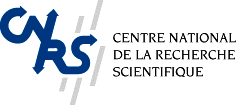Tuesday night, December 5th at 19h45 Hawaiian time, the first data
cube scanning the s(1)(1-0) line of molecular hydrogen at 2.12
microns was obtained with GriF, an imaging spectrograph, with
Fabry-Perot, attached behind the adaptive optics bonnette of the
Canada-France-Hawaii Telescope. The Planetary nebula NGC 7027 was the
target.
This week's image features the next set of images taken by GriF on the
Orion Molecular Cloud, OMC-1. Not bad for a first night! Not bad
indeed! The region next to the Becklin-Neugebauer object is visible,
with the so-called bullets: blobs of material, part of a large scale
molecular outflow being ejected at high speed.
As can be seen on this image, coupling a scanning Fabry-Perot to an
adaptive optics imager allows to obtain not only spectral resolution
to study the kinematics of the field, but also provides improved
angular resolution. Obviously, the scientific interpretation is still
very preliminary as the data were obtained only a few hours ago. But
the data set contains, simultaneously, some of the finest
angular resolution pictures of the zone AND large enough spectral
resolution to study the detailed kinematics of this spectacular complex.
Technical description:
The velocity field is color coded in the image. Material moving toward
us is shown in blue, while material receding from us appears in red.
The complex velocity field of the outflow and the "bullets" are
apparent. Note that the image has not been treated for cosmetics yet.
GriF, the instrument, is designed for use in the K-band for now
but its capacities could be extended to the H-band. During this first
observing run, only a warm scanning Fabry-Perot was used in front of
the infrared camera (KIR). But KIR will soon be equipped with a cold
grism and mask assembly, inside the cryostat. The next observations
with GriF are scheduled for next May, after the upgrade.




